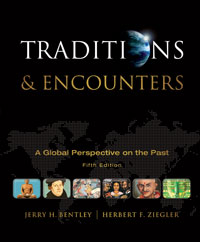Traditions and Encounters, AP Edition (Bentley), 5th EditionChapter 36:
New Conflagrations: World War II and the Cold WarOverviewThe Second World War (1939-1945) was indeed a conflagration such as the world had never seen before. There was no precedent for the scale of the devastation, the millions of dead, the unimaginable barbarity. World War II was the defining event of the twentieth century. It determined the global powers, the global alignments, and many of the issues for the next generation. Two superpowers emerged from the ashes, the United States and the Soviet Union. Former allies, the two were now actively hostile, but they repeatedly stopped short of a full-out war. The prospect of a nuclear confrontation was too awful to contemplate. Aspects of the war to consider as you read include the following: - Appeasement. The causes of the war were complex but include the failure of western democracies to take seriously the threat of fascism. When Japan invaded Manchuria in 1931, when Italy seized Ethiopia in 1935, when Germany claimed first the Sudetenland and then all of Czechoslovakia in 1938: at every turn, world leaders decided to appease the aggressor rather than risk a war.
- Isolationism. Sunk in the depression, Britain, France, and the United States erected walls of tariffs against imports, which only deepened the global depression. Disillusioned with the outcome of World War I, the western democracies did not maintain their military strength. When the next war came, they were ill prepared.
- Total war. Like the first World War, the second involved whole populations on an unprecedented scale. Women on both sides performed industrial work and joined auxiliary forces. Civilians were targets of war through aerial attacks, blockades, rape, and internment. Civilian casualties were in the tens of millions.
- Genocide. Certainly the most horrifying aspect of the war was the Nazi attempt to methodically exterminate the entire Jewish population of Europe, along with other “undesirable” populations. Nearly six million Jews were killed in the death camps.
- An uneasy alliance. Capitalist and communist states found common cause in the battle against fascism. By keeping up the pressure on two fronts, the Allies eventually crushed the Axis empire. However, by the end of the war, the alliance between Britain, the United States, and the Soviet Union was frayed and unstable.
- The arms race. The logic of the cold war drove both superpowers to stockpile nuclear weapons in order to match one another's destructive capabilities. The two powers were evenly matched in the 1960s, but by the 1980s the effort had severely strained the Soviet economy.
- Bipolar alliances. The cold war saw new defensive alliances, NATO in the west and the Warsaw Pact of the Soviet satellites. The world was divided into two camps.
- Aggressive saber-rattling. Although the superpowers avoided direct and full-scale war, a number of minor conflicts sapped their energies and resources: Berlin, Korea, Hungary, Cuba, and Czechoslovakia.
 |  |

















